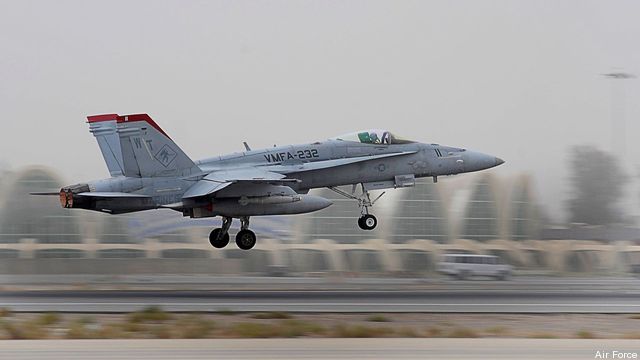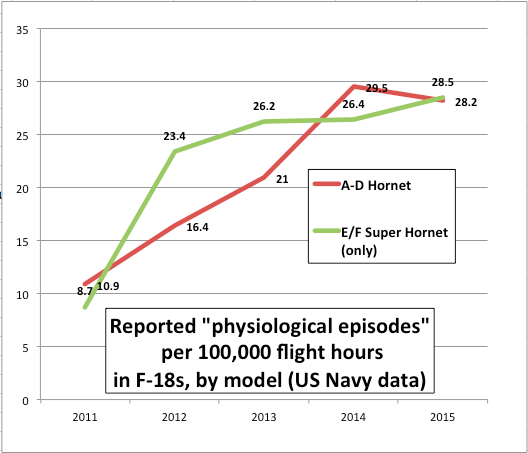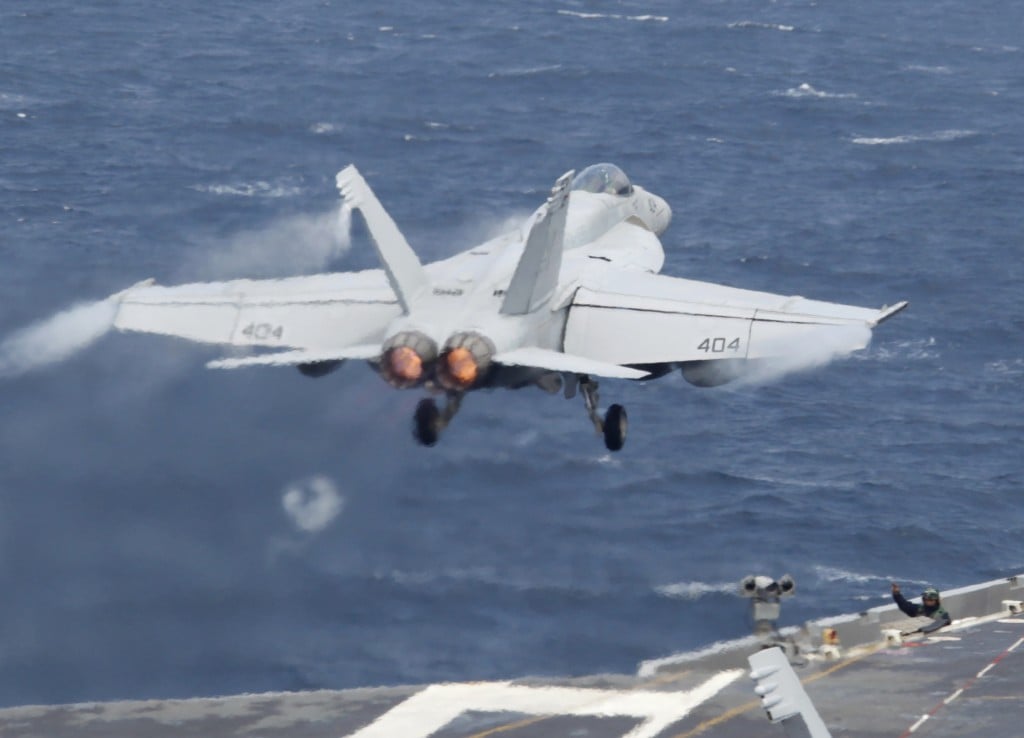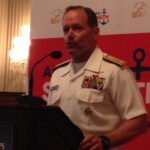Oxygen Problems Afflicted 297 Navy & Marine Hornets
Posted on

Marine F-18 Hornet
CAPITOL HILL: It turns out Navy pilots like to breathe. That’s a potential problem in the Navy’s mainstay fighter, the F-18 Hornet, which is suffering failures of its On-Board Oxygen Generation System (OBOGS). While rare, a single case of in-flight oxygen deprivation could potentially kill the pilot, destroy a $30 million to $60 million aircraft, or both — and after five years, the Navy’s still searching for a fix.
“I’m concerned about the high rate of hypoxia — which is caused by a lack of oxygen — and other physiological events apparently being experienced by the crew members of F-18 aircraft over the past five years,” said Rep. Niki Tsongas, a senior Democrat on the House Armed Services subcommittee on tactical air and land forces.
Oxygen deprivation can make a pilot dizzy or confused, both dangerous states of mind when hurtling at hundreds of miles per hour through the air. F-18s carry backup bottles of oxygen as well, but Tsongas noted that emergency supply must be turned on manually — which a sufficiently logy pilot may not be able to do. (After experiencing similar problems, the Air Force F-22 eventually went to an automatic backup). The auxiliary oxygen supply also only lasts about 10 minutes. That’s not necessarily enough to get back to the base or aircraft carrier and land safely.
Navy documents record 297 incidents for all types of F-18 from May 2010 through October 2015. In fact, reports of problems have been increasing, although that may be the result of a full-court press to raise awareness.

Note: reporting years run from 1 November through 31 October
“None of the incidents….have resulted in loss or damage of an aircraft,” say the Navy papers, which Breaking Defense obtained. “In all but one instance, the pilot made a full recovery from the episode.” We don’t have information on what happened to that one pilot.
The problem occurs at roughly equal rates both in the aging A/B/C/D models built by the former McDonnell-Douglas and in the newer E/F Super Hornets and EA-18G Growlers being currently built by Boeing. That’s true even though the old and new jets have different oxygen systems. While the baseline Hornets use bulky bottles of liquid oxygen, like most aircraft since the 1940s, the Super Hornets and Growlers use Cobham-built On-Board Oxygen Generation Systems (OBOGS) that purify air from the engine intakes, theoretically giving them an unlimited supply of oxygen — as long as OBOGS works.
“The older F-18s are having problems due, it seems, to the cabin pressure system and possible contamination,” a Hill staffer told me. “The relatively new Super Hornets are having problems as well, at almost the same rate, but the Navy seems to think it is related to the onboard oxygen generation/filtration system.”

Navy F/A-18 Super Hornet
Fixing The F-18
Unsurprisingly, subcommittee chairman Rep. Mike Turner singled out “physiological events” as a top issue for today’s hearing with two admirals and the Marine Corps’ deputy commandant for aviation. Similar oxygen problems led to the grounding of the entire Air Force F-22 fleet in 2011. I’ve seen no mention that the two services are cooperating on the current problem, but the Navy’s well aware of the Air Force history.
The Navy documents even note the F-22 and the late-model (E/F/G) Super Hornets use “very similar” on-board oxygen generation systems (OBOGS). But one big factor for the F-22 doesn’t apply here: a faulty g-suit vest, the “Upper Pressure Garment,” that the Navy doesn’t use. In part as a result, grounding the F-18 isn’t on the table.

Rear Adm. Mike Manazir
“If we had a confidence problem in the airplane, we would ground the fleet,” said Rear Adm. Michael Manazir, the director of air warfare on the Navy staff and an F-18 pilot himself. “I’ve never experienced a hypoxic event outside of training,” when pilots are deliberately subjected to partial oxygen deprivation so they learn the warning signs.
“I’m very confident in my Navy team here to go fix the O-box problem,” said Marine Lt. Gen. Jon Davis. (The Navy runs the back office support for many Marine Corps systems). “The Marines love flying the F-18, it’s a workhorse for us, we don’t worry that much about the O-box [oxygen system] right now.”
“My youngest son’s a Marine F-18 pilot [who] just got back from deployment,” Davis said. “I think he’s more worried about the numbers of airplanes on the line for him to go train than he is the O-box.” Unrelated maintenance issues have grounded almost 20 percent of the Marine Corps’ often-aging aircraft.

Lt. Gen. Jon Davis
Despite five years of watching the F-18 oxygen systems closely, however, the Navy still doesn’t know why the air supply is failing, Manazir admitted. “It’s like chasing a ghost,” he said. “We can’t figure out, because the monitoring devices that do this are not on the airplane,” whether a given incident results from too little oxygen, too much oxygen, excessive carbon monoxide, or some kind of toxin leaking into the air.
“Monitoring the quality of the breathing gas requires complex instrumentation not currently available in a small, lightweight, robust configuration suitable for aircraft use,” the Navy documents say. “Mitigation efforts underway include developing such a system.”
“Right now we don’t have a good way to measure that [air quality],” said Rear Adm. Michael Moran, the program executive officer for tactical aircraft at Naval Air Systems Command. “[We’re] testing a couple of things down in Pax River that we can put into their emergency gear to measure the gas.”

Rear Adm. Michael Moran
The Navy’s working hard, Moran assured Congress: “It’s discussed on a monthly basis at the three-star level, so every incident that occurs comes to my desk, if not daily, then certainly weekly.”
The Navy documents list 13 different measures being taken to improve the situation. The service is fielding new carbon monoxide scrubbers, “molecular sieves” to extract nitrogen, and depressurization warning indicators. It’s revising procedures for maintenance of the oxygen generators, environmental control systems, and pressurization systems. It’s developing monitoring systems for oxygen, contaminants, and human performance, as well as an alternative oxygen source. And it’s working to update operating procedures and raise awareness in the fleet.
The Navy’s efforts to fix the problem are appreciated, Rep. Tsongas told the officers, but “despite all your efforts and investments and policies and training and everything else, the numbers still don’t go down.”
Subscribe to our newsletter
Promotions, new products and sales. Directly to your inbox.
